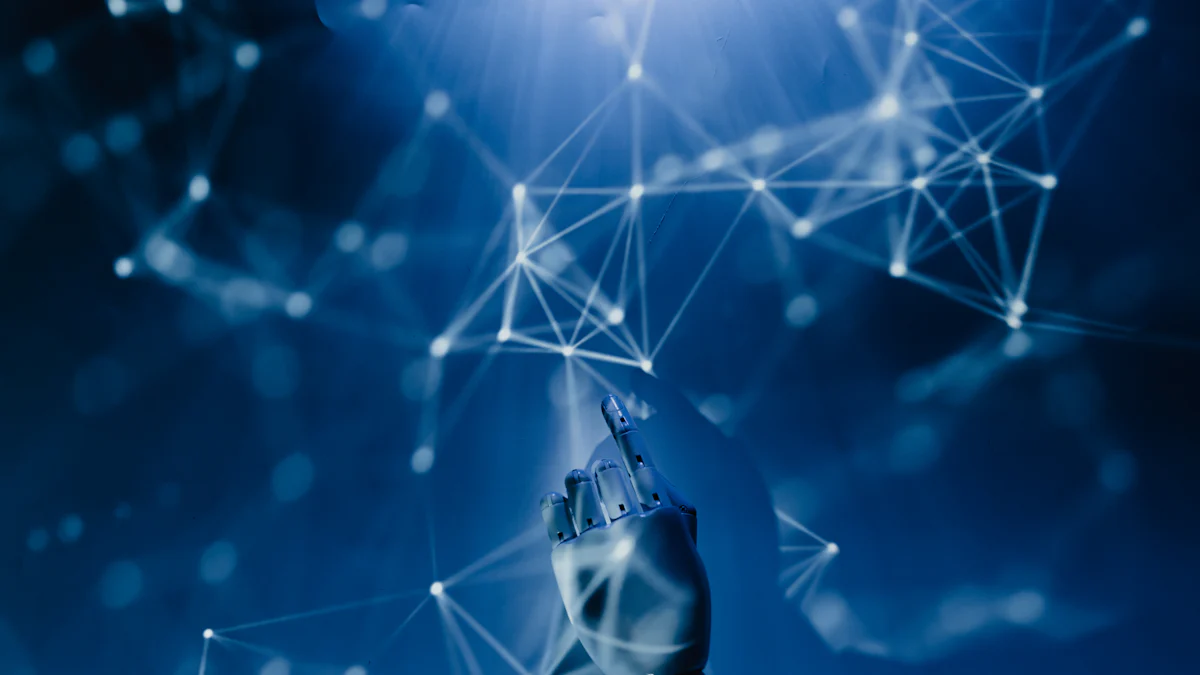How Generative AI Could Change the Job Market

Generative AI is revolutionizing the way we work by automating routine tasks and enhancing productivity. This technology can analyze vast datasets, recognize patterns, and predict outcomes, offering invaluable insights for business strategies. As AI advances, its influence on the job market becomes more pronounced. Understanding this dynamic is essential for you as a professional or job seeker navigating the evolving employment ecosystem. With the potential to automate up to 300 million full-time jobs in the U.S. and Europe, Generative AI is reshaping the landscape of work, making it crucial to explore its impact thoroughly.
Understanding Generative AI
Definition and Examples
What is Generative AI?
Generative AI refers to a class of artificial intelligence systems that can create new content. These systems learn from existing data and use algorithms to generate text, images, music, and more. You might have heard of Generative Adversarial Networks (GANs), which are popular methods used in this field. GANs consist of two neural networks that work together to produce new data. This technology is rapidly expanding, driven by the growing adoption of digital technologies and the convenience of online services.
Real-world applications in various industries
Generative AI finds applications across numerous industries. In healthcare, it assists in creating personalized treatment plans by analyzing patient data. In the entertainment industry, it generates realistic graphics and animations for movies and video games. The technology also impacts creative fields by producing original artwork and music. Businesses use Generative AI to enhance marketing strategies by generating engaging content tailored to specific audiences. These examples illustrate how Generative AI is transforming traditional roles and creating new opportunities.
Technological Advancements
Recent breakthroughs in AI technology
Recent advancements in Generative AI have led to significant breakthroughs. Researchers have developed sophisticated algorithms that improve the quality and efficiency of generated content. For instance, AI systems now assist in software development by generating and optimizing code. This capability impacts software engineering jobs by streamlining processes and reducing manual effort. The deployment of large language models further enhances the ability of AI to understand and generate human-like text, making it a valuable tool in various sectors.
Future potential of generative AI
The future potential of Generative AI is vast. As technology continues to evolve, you can expect even more innovative applications. The creation of virtual worlds and conversational AI abilities are areas poised for growth. Generative AI will likely play a crucial role in developing immersive experiences and enhancing human-computer interactions. As these advancements unfold, the demand for skilled professionals who can harness the power of Generative AI will increase, reshaping the job market and redefining skill requirements.
Current State of the Job Market
Overview of Employment Trends
Key statistics and data
The job market is undergoing significant changes. You might notice a shift in employment trends as technology continues to evolve. According to recent studies, more than 30% of workers could see at least half of their tasks disrupted by generative AI. This disruption presents both challenges and opportunities for you as a job seeker or professional. The integration of AI into various sectors has led to the creation of new roles, while also posing a risk of job displacement in certain industries.
Current challenges faced by the workforce
The workforce faces several challenges in adapting to these changes. One major challenge is the need for upskilling and reskilling. As AI automates routine tasks, you may find that your current skills are no longer sufficient. The demand for AI-related skills is on the rise, and staying competitive requires continuous learning. Additionally, the risk of job displacement looms over many sectors, making it crucial for you to be proactive in acquiring new skills and exploring emerging job opportunities.
Role of Technology in Employment
Historical impact of technology on jobs
Technology has always played a pivotal role in shaping the job market. Historically, technological advancements have led to both job creation and displacement. For instance, the Industrial Revolution introduced machinery that transformed manufacturing processes, resulting in the loss of some jobs but also creating new ones. Similarly, the digital revolution brought about significant changes in how businesses operate, leading to the emergence of new industries and job roles.
Current technological influences
Today, technology continues to influence employment in profound ways. Generative AI, in particular, is reshaping job roles and skill requirements. You might notice that AI is automating tasks that were once considered essential, such as data entry and analysis. This automation allows you to focus on more complex and creative aspects of your job. However, it also means that you need to adapt to new technologies and develop skills that complement AI systems. The rise of AI-related roles, such as AI ethicists and data curators, highlights the evolving nature of the job market and the importance of staying informed and adaptable.
Potential Job Creation

New Industries and Roles
Emerging sectors driven by AI
Generative AI is not just about replacing jobs; it is also about creating new opportunities. As AI technology advances, you will see the emergence of entirely new industries. These sectors focus on developing, managing, and ensuring the ethical use of AI technologies. For instance, the rise of AI has led to the creation of roles like AI ethicists, who ensure that AI systems operate fairly and without bias. Machine learning engineers are also in high demand, as they design and implement AI models that drive innovation across various fields.
Examples of new job roles
The integration of AI into the workforce has resulted in a variety of new job roles. You might find positions such as data curators, who organize and maintain large datasets for AI systems. AI trainers are another example, as they teach AI models to understand and process human language. Additionally, AI has enabled professionals to focus more on the human aspects of their work. With AI handling routine tasks, you can concentrate on creativity, problem-solving, and collaboration. This shift highlights the synergy between AI and people skills, opening up roles that emphasize these human qualities.
Skill Development and Education
Importance of upskilling
In this rapidly changing job market, upskilling becomes crucial. As AI continues to evolve, you need to adapt by acquiring new skills that complement AI technologies. Upskilling allows you to stay relevant and competitive in your field. It involves learning new tools, techniques, and methodologies that enhance your ability to work alongside AI systems. By focusing on skill development, you can better position yourself for the emerging job roles that AI creates.
Educational programs and initiatives
To support this transition, various educational programs and initiatives have emerged. Many institutions now offer courses in AI and machine learning, providing you with the knowledge needed to thrive in AI-driven industries. Online platforms also offer flexible learning options, allowing you to study at your own pace. These programs cover a range of topics, from basic AI concepts to advanced machine learning techniques. By participating in these educational opportunities, you can equip yourself with the skills necessary to navigate the evolving job market and seize new opportunities created by generative AI.
Job Displacement Concerns

Sectors at Risk
Industries most vulnerable to AI disruption
Generative AI is reshaping the job market, and some industries face higher risks of disruption. You might notice that sectors relying heavily on routine tasks are particularly vulnerable. For instance, manufacturing and logistics often involve repetitive processes that AI can automate. In these industries, AI systems can perform tasks like quality control and inventory management more efficiently than humans. Similarly, administrative roles in finance and customer service face challenges as AI takes over data entry and basic customer interactions.
Case Studies:
Manufacturing: In a recent study, AI-driven automation in manufacturing led to a 20% reduction in manual labor. Companies implemented AI for tasks like assembly line monitoring and predictive maintenance.
Finance: Financial institutions have adopted AI for fraud detection and risk assessment. This shift has reduced the need for traditional roles in data analysis and reporting.
Case studies of job displacement
The impact of AI on job displacement is evident in various real-world scenarios. In the retail sector, AI-powered checkout systems have replaced cashiers in several stores. This change has streamlined operations but also resulted in job losses. In another example, AI-driven chatbots in customer service have reduced the demand for human agents. These chatbots handle routine inquiries, allowing companies to cut costs but also leading to fewer entry-level positions.
Case Studies:
Retail: A major retail chain implemented AI checkout systems, reducing cashier positions by 30%. The company reported increased efficiency and customer satisfaction.
Customer Service: A telecommunications firm introduced AI chatbots, decreasing the need for human agents by 40%. This transition improved response times but required employees to seek new roles.
Mitigation Strategies
Policy recommendations
To address job displacement concerns, policymakers must take proactive steps. You should advocate for policies that support workers transitioning to new roles. Governments can invest in retraining programs that equip individuals with skills relevant to AI-driven industries. Additionally, implementing social safety nets can provide financial support during periods of unemployment. Encouraging collaboration between educational institutions and businesses can also ensure that training programs align with industry needs.
Policy Recommendations:
Invest in retraining and upskilling programs.
Develop social safety nets for displaced workers.
Foster partnerships between educational institutions and businesses.
Role of businesses and governments
Businesses and governments play crucial roles in mitigating the impact of AI on employment. As a business leader, you can prioritize reskilling initiatives within your organization. Offering training programs helps employees adapt to new technologies and roles. Governments, on the other hand, can create incentives for companies that invest in workforce development. By working together, businesses and governments can create a supportive environment for workers navigating the changing job landscape.
Strategies for Businesses and Governments:
Businesses should implement reskilling programs.
Governments can offer tax incentives for workforce development.
Collaboration between sectors can drive positive change.
Ethical and Social Implications
Bias and Fairness in AI
Challenges of ensuring unbiased AI systems
Generative AI systems can reflect the biases present in the data they are trained on. You might wonder how these biases emerge. They often stem from historical data that contains prejudices or stereotypes. When AI systems learn from such data, they can inadvertently perpetuate these biases. This poses a significant challenge as biased AI systems can lead to unfair outcomes in areas like hiring, lending, and law enforcement.
Ensuring unbiased AI systems requires vigilance. You need to be aware that biases can manifest in various forms, such as gender, race, or socioeconomic status. The complexity of AI algorithms makes it difficult to identify and eliminate all biases. However, understanding the sources of bias is the first step toward addressing them.
Strategies for promoting fairness
Promoting fairness in AI involves several strategies. First, you should advocate for diverse and representative datasets. By including a wide range of perspectives and experiences, you can help reduce bias in AI systems. Additionally, transparency in AI development is crucial. You should demand clear explanations of how AI systems make decisions. This transparency allows for accountability and helps identify potential biases.
Collaboration is another key strategy. Engaging with experts from various fields, including technologists, policymakers, and cultural practitioners, can provide valuable insights into the ethical implications of AI. By fostering interdisciplinary dialogue, you can work towards creating AI systems that are fair and equitable.
Societal Impact
Changes in work-life balance
Generative AI is reshaping the way you work, impacting your work-life balance. AI systems can automate routine tasks, allowing you to focus on more meaningful and creative aspects of your job. This shift can lead to increased job satisfaction and a better work-life balance. However, it also presents challenges. The blurring of boundaries between work and personal life can lead to burnout if not managed properly.
To maintain a healthy work-life balance, you should set clear boundaries and prioritize self-care. Embracing flexible work arrangements and leveraging AI tools to streamline tasks can help you achieve a more balanced lifestyle.
Social equity considerations
The rise of generative AI raises important questions about social equity. You might notice that access to AI technologies is not evenly distributed. This disparity can exacerbate existing inequalities, as those with access to AI tools gain a competitive advantage in the job market. Ensuring equal access to AI technologies is essential for promoting social equity.
Policymakers and regulators play a crucial role in addressing these concerns. Legal frameworks should be established to ensure that the benefits of AI are shared equitably. By advocating for policies that promote equal access and address bias, you can contribute to a more just and inclusive society.
Predictions for the Future
Long-term Impact on Employment
Expert opinions and forecasts
Generative AI will significantly reshape the job market. The World Economic Forum (WEF) predicts that AI and automation will displace 85 million jobs. However, it also foresees the creation of 97 million new jobs due to the AI revolution. This shift highlights the dual nature of AI's impact. While some roles may vanish, others will emerge, requiring new skills and expertise.
"AI will spark a massive reshuffling of the job market," labor experts say.
Goldman Sachs and McKinsey emphasize the importance of retraining in response to technological advancements. They highlight AI's dual role in disrupting existing professions while increasing the demand for new skills. According to Goldman Sachs, generative AI could automate up to 300 million full-time jobs in the U.S. and Europe. McKinsey predicts that by 2030, generative AI will automate 29.5% of the hours performed in the U.S. economy, up from 21.5% now.
Potential scenarios for the job market
The future job market will likely experience a mix of displacement and creation. You might see traditional roles evolve as AI takes over routine tasks. New opportunities will arise in sectors focused on AI development and management. The demand for AI-related skills will grow, leading to a shift in the skills hierarchy. As AI continues to advance, you can expect a reconfiguration of the job pyramid, with an increased emphasis on human skills like creativity and critical thinking.
Preparing for the Future
Steps individuals can take
To thrive in this evolving landscape, you should take proactive steps. First, embrace continuous learning. Stay informed about AI advancements and their implications for your field. Seek out educational programs that offer training in AI and related technologies. By doing so, you can equip yourself with the skills needed to navigate the changing job market.
Steps to Prepare:
Embrace continuous learning.
Stay informed about AI advancements.
Seek educational programs in AI.
Role of continuous learning
Continuous learning plays a crucial role in preparing for the future. As AI reshapes job roles, you must adapt by acquiring new skills. Focus on developing abilities that complement AI technologies, such as problem-solving and collaboration. By prioritizing continuous learning, you can remain competitive and seize new opportunities created by generative AI.
Conclusion
Summary of Key Points
Recap of generative AI's potential impact
Generative AI is transforming the job market by automating routine tasks and creating new opportunities. It can analyze vast datasets, recognize patterns, and predict outcomes, offering invaluable insights for business strategies. This technology has the potential to automate up to 300 million full-time jobs in the U.S. and Europe. However, it also opens doors to new industries and roles, emphasizing the importance of human skills like creativity and critical thinking.
Final thoughts on navigating changes
As you navigate these changes, focus on continuous learning and skill development. Embrace the opportunities that generative AI presents while being mindful of its challenges. Stay informed about AI advancements and seek educational programs that enhance your abilities. By doing so, you can position yourself for success in an evolving job market. Remember, the future of work is not just about adapting to technology but also about leveraging it to create a more fulfilling and balanced professional life.
Generative AI presents both opportunities and challenges. It automates tasks, creating new roles while displacing others. You must adapt and learn continuously to thrive in this evolving landscape. Embrace the chance to develop skills that complement AI technologies.
"AI-generated creations challenge traditional notions of authorship and creativity, blurring the lines between human and machine-generated content."
Stakeholders, including businesses and governments, should collaborate to shape a positive future. By promoting diversity and inclusion in AI development, we can address societal biases and stereotypes. Together, we can harness AI's potential to enhance creativity and representation, ensuring a balanced and equitable job market.
See Also
Is Generative AI Capable of Replacing Human Artists?
The Future of Creativity and Innovation: Generative AI
The Art Revolution by Generative AI
Transforming Educational Content Creation with Generative AI
